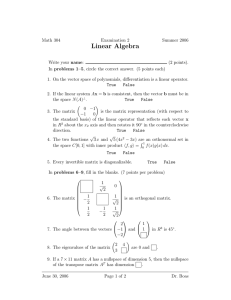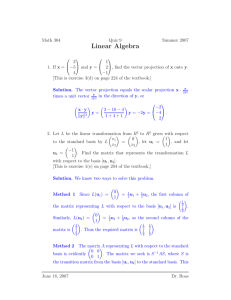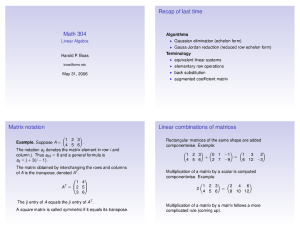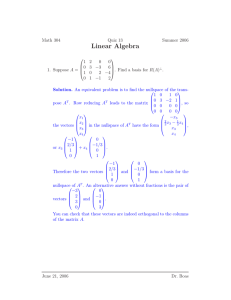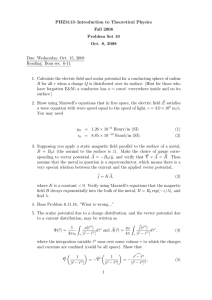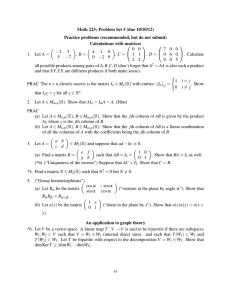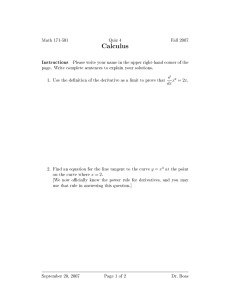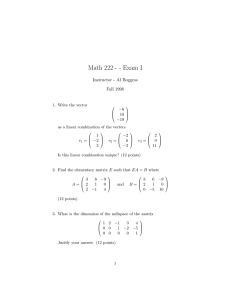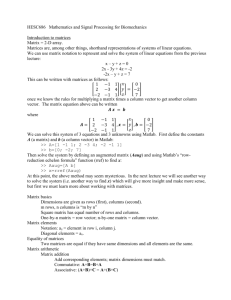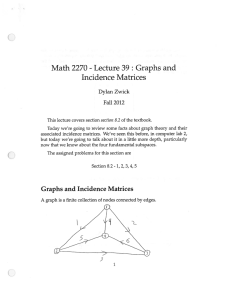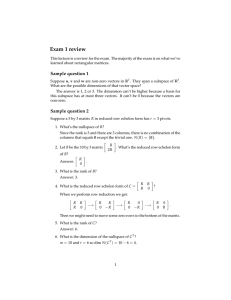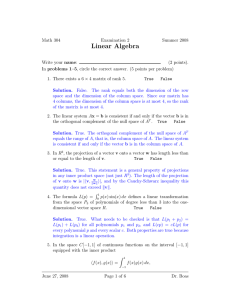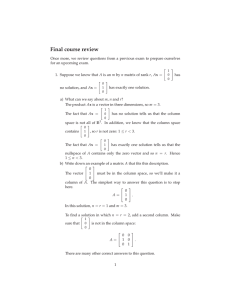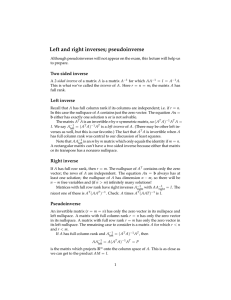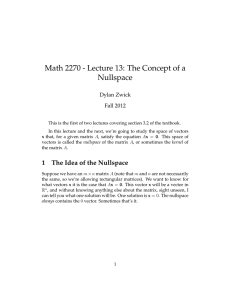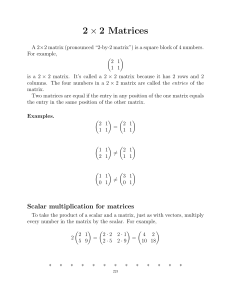Linear Algebra
advertisement
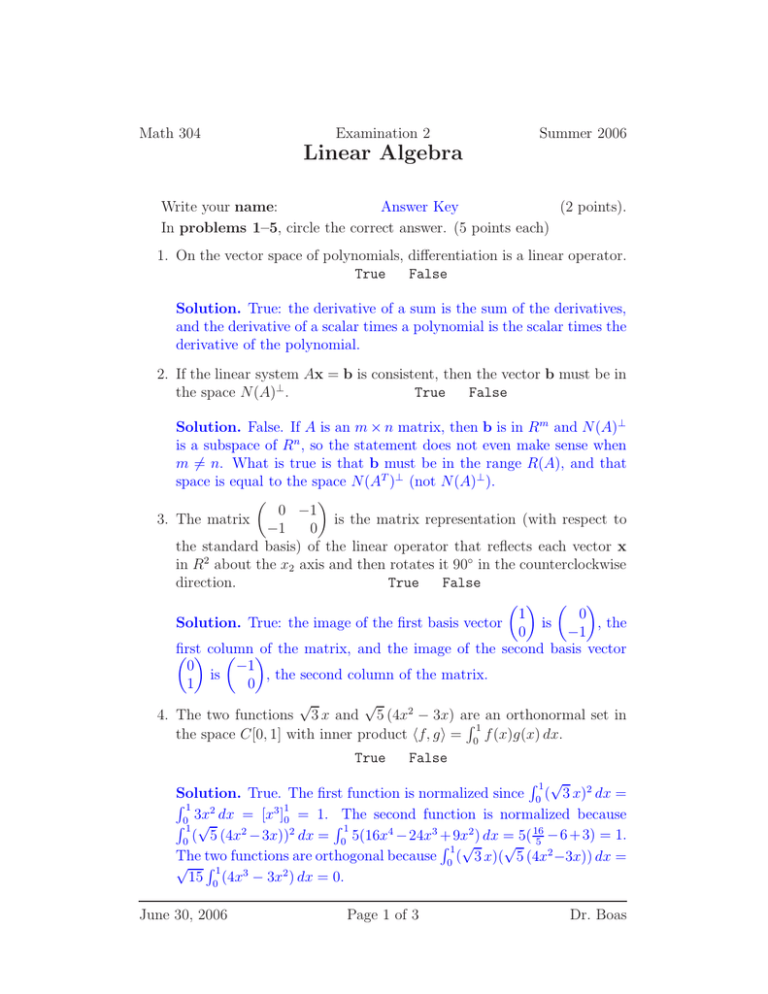
Math 304 Examination 2 Summer 2006 Linear Algebra Write your name: Answer Key (2 points). In problems 1–5, circle the correct answer. (5 points each) 1. On the vector space of polynomials, differentiation is a linear operator. True False Solution. True: the derivative of a sum is the sum of the derivatives, and the derivative of a scalar times a polynomial is the scalar times the derivative of the polynomial. 2. If the linear system Ax = b is consistent, then the vector b must be in the space N(A)⊥ . True False Solution. False. If A is an m × n matrix, then b is in Rm and N(A)⊥ is a subspace of Rn , so the statement does not even make sense when m 6= n. What is true is that b must be in the range R(A), and that space is equal to the space N(AT )⊥ (not N(A)⊥ ). 0 −1 is the matrix representation (with respect to 3. The matrix −1 0 the standard basis) of the linear operator that reflects each vector x in R2 about the x2 axis and then rotates it 90◦ in the counterclockwise direction. True False 1 0 Solution. True: the image of the first basis vector is , the 0 −1 first of the matrix, and the image of the second basis vector column −1 0 , the second column of the matrix. is 0 1 √ √ 4. The two functions 3 x and 5 (4x2 − 3x) are R 1 an orthonormal set in the space C[0, 1] with inner product hf, gi = 0 f (x)g(x) dx. True False R1 √ Solution. True. The first function is normalized since 0 ( 3 x)2 dx = R1 2 1 3x dx = [x3 ]0 = 1. The second function is normalized because 0 √ R1 R1 − 6 + 3) = 1. ( 5 (4x2 − 3x))2 dx = 0 5(16x4 − 24x3 + 9x2 ) dx = 5( 16 0 √ 5 2 R1 √ The two functions are orthogonal because 0 ( 3 x)( 5 (4x −3x)) dx = √ R1 3 15 0 (4x − 3x2 ) dx = 0. June 30, 2006 Page 1 of 3 Dr. Boas Math 304 Examination 2 Summer 2006 Linear Algebra 5. Every invertible matrix is diagonalizable. True False 1 1 Solution. False. For example, the matrix is invertible but 0 1 cannot be diagonalized because the only eigenvalue is 1, and the corresponding eigenspace is spanned by the single eigenvector (1, 0)T . The matrix does not admit a basis of eigenvectors. In problems 6–9, fill in the blanks. (7 points per problem) 1 √ 2 1 − 2 1 2 1 √ 2 1 2 1 − 2 0 1 is an orthogonal matrix. √ 2 1 √ 2 1 2 7. The angle between the vectors −1 and 1 in R3 is 45◦ . −2 −4 2 4 are 0 and 8 . 8. The eigenvalues of the matrix 3 6 6. The matrix 9. If a 7 × 11 matrix A has a nullspace of dimension 5, then the nullspace of the transpose matrix AT has dimension 1 . In problems 10–12, show your work and explain your method. Continue on the back if you need more space. (15 points each) 3 1 2 3 . If x = , and v2 = , v1 = , u2 = 10. Suppose u1 = 8 3 5 7 4u1 + 3u2 , find numbers c1 and c2 such that x = c1 v1 + c2 v2 . Solution. This is a problem about change of basis, but it can be solved from first principles. The problem amounts to solving the system 1 3 c1 3 2 4 = . 3 8 c2 7 5 3 June 30, 2006 Page 2 of 3 Dr. Boas Math 304 Examination 2 Summer 2006 Linear Algebra You can multiply out the right-hand side and solve by row reduction, or alternatively multiply by an inverse matrix (this amounts to the change of basis formula) to get −1 c1 1 3 3 2 4 −15 = = . c2 3 8 7 5 3 11 3 1 2 x1 = 0. 11. Find a least-squares solution of the system −1 3 x2 4 1 1 Solution. The associated least-squares problem is 3 1 2 1 −1 1 x 1 −1 1 0 , −1 3 1 = 2 3 1 x2 2 3 1 4 1 1 7 x1 3 0 . = 10 x2 0 14 or Therefore x1 = 7/3 and x2 = 10/14 = 5/7. 2 a −9 3 0 0 2 −6 and 0 0 0 are similar. Find the 12. The matrices −4 −2 −5 3 0 0 4 value of the number a. Solution. There are several ways to see that a = 11. One way is to observe that similar matrices have equal determinants: set the determinant of the first matrix equal to 0 and solve for a. Alternatively, observe that similar matrices have the same eigenvalues: in this case, 3, 0, and 4. So row reduce the matrix A − 3I and find what condition on a guarantees a non-trivial nullspace; or row reduce A − 0I or A − 4I. Another method is to observe that the first matrix must have rank 2 (since the second matrix has rank 2), so one of the columns must be a linear combination of the other columns. One can see by inspection that the middle column of the first matrix must be the first column minus the third column. June 30, 2006 Page 3 of 3 Dr. Boas
